Energy-efficient windows are essential for enhancing the comfort and sustainability of historic homes while preserving their unique character. By minimizing heat transfer and improving insulation, these windows not only reduce energy consumption but also help maintain the integrity of older structures in line with modern performance standards.
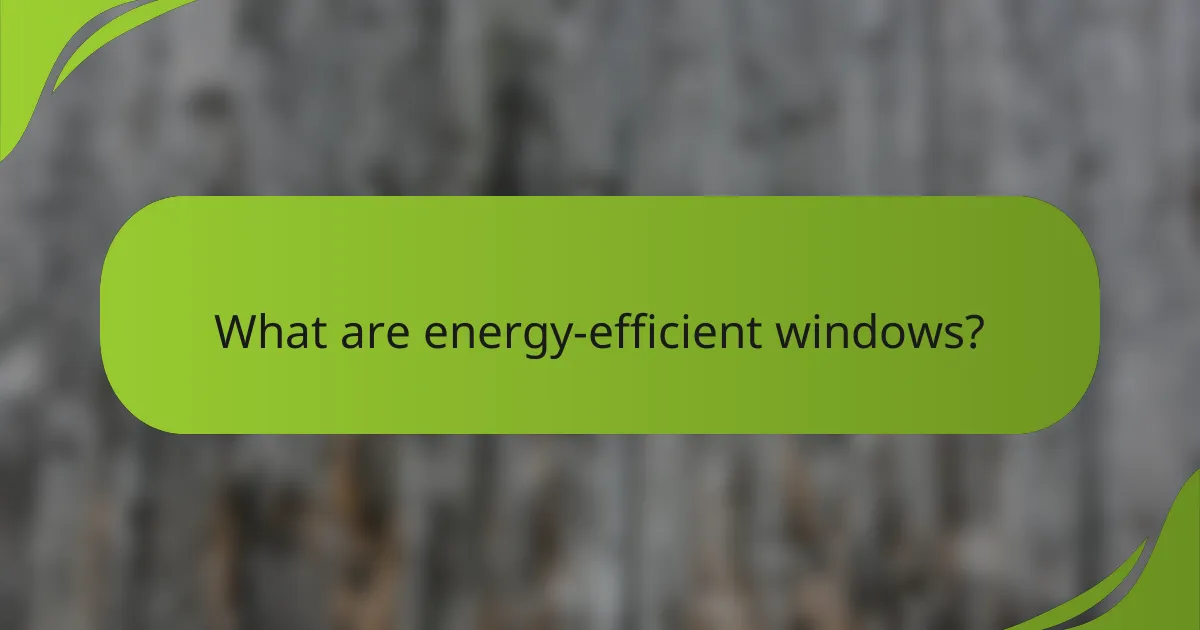
What are energy-efficient windows?
Energy-efficient windows are designed to minimize heat transfer, thereby reducing energy consumption for heating and cooling. They typically feature advanced glazing, frames, and spacers that improve insulation and overall performance.
Definition of energy-efficient windows
Energy-efficient windows are windows that help maintain a comfortable indoor temperature while reducing energy costs. They are built with materials and technologies that enhance thermal performance, such as low-emissivity (Low-E) coatings and insulated frames.
These windows are often rated based on their energy performance, which can be verified through certifications like ENERGY STAR in the United States or similar standards in other countries. This ensures they meet specific efficiency criteria.
Key features of energy-efficient windows
Several key features distinguish energy-efficient windows from standard options. These include multiple panes of glass, which create insulating air spaces, and Low-E coatings that reflect heat back into the room during winter and keep it out during summer.
Additionally, energy-efficient windows often have improved frame materials, such as vinyl or fiberglass, which provide better insulation than traditional wood or aluminum frames. Proper installation is crucial to maximize their benefits, as gaps can lead to significant energy loss.
- Low-E glass for reduced UV rays and heat transfer
- Argon or krypton gas fills for enhanced insulation
- Multi-chambered frames to minimize thermal bridging
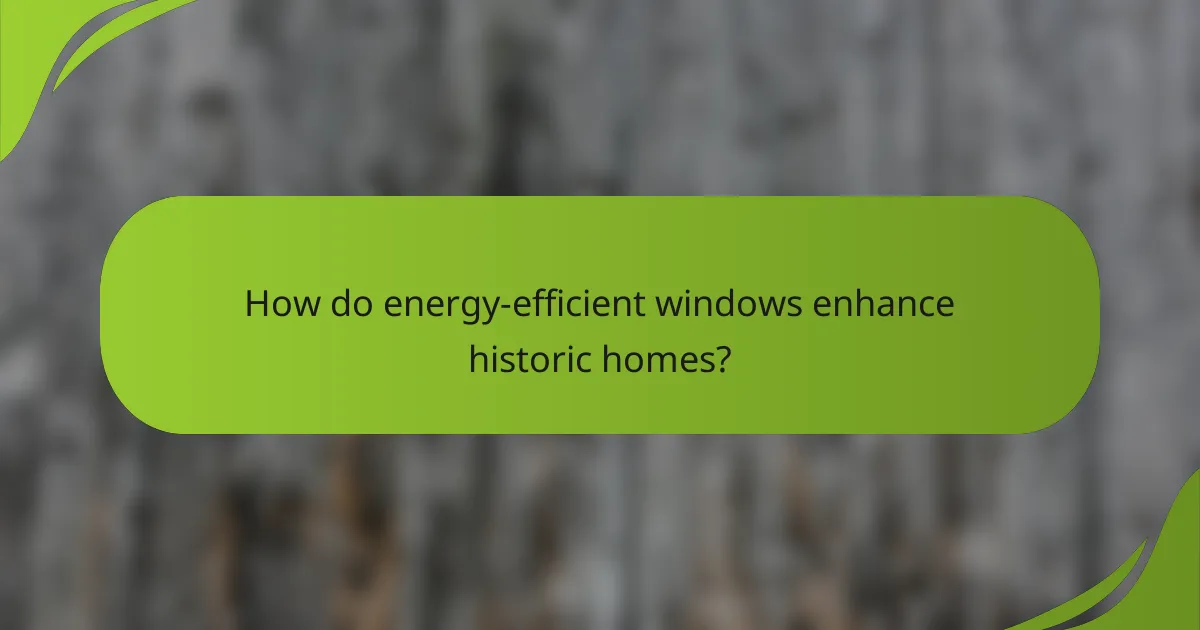
How do energy-efficient windows enhance historic homes?
Energy-efficient windows improve historic homes by providing better insulation and reducing energy costs while maintaining the building’s character. These windows can help preserve the integrity of older structures while ensuring they meet modern performance standards.
Compatibility with historic architecture
When selecting energy-efficient windows for historic homes, it is crucial to choose designs that align with the original architectural style. Options such as double-hung or casement windows can be customized to match the historic look while incorporating modern materials that enhance energy performance.
Additionally, many manufacturers offer windows that replicate the appearance of traditional materials, such as wood or metal, ensuring that the new installations do not detract from the home’s historical value. Local regulations may also dictate specific requirements for window replacements in historic districts, so consulting with local preservation guidelines is essential.
Preservation of aesthetic integrity
Maintaining the aesthetic integrity of historic homes is vital when upgrading to energy-efficient windows. Homeowners should consider window frames, grid patterns, and glass types that reflect the original design to keep the visual appeal intact.
Using low-emissivity (Low-E) glass can enhance energy efficiency without compromising clarity or color. It’s advisable to seek windows that offer a balance between modern performance and traditional aesthetics, ensuring that the home retains its charm while benefiting from improved energy savings.
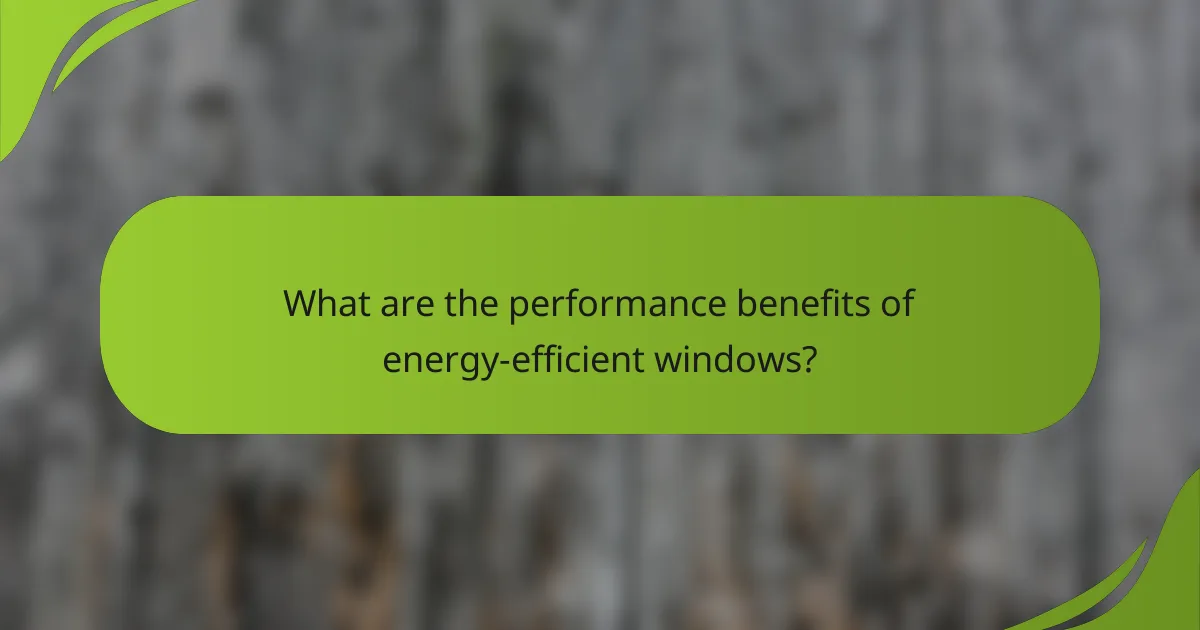
What are the performance benefits of energy-efficient windows?
Energy-efficient windows provide significant performance benefits, including enhanced insulation and lower energy costs. These windows are designed to minimize heat transfer, keeping homes comfortable while reducing reliance on heating and cooling systems.
Improved insulation properties
Energy-efficient windows are constructed with advanced materials and technologies that enhance their insulation properties. Features such as double or triple glazing, low-emissivity (Low-E) coatings, and argon gas fills help reduce heat loss in winter and heat gain in summer.
When selecting windows, look for those with a low U-factor, which measures the rate of heat transfer. A U-factor below 0.30 is generally considered good for residential windows, ensuring better thermal performance.
Reduction in energy costs
By improving insulation, energy-efficient windows can lead to a noticeable reduction in energy costs. Homeowners may experience savings of 10-25% on their heating and cooling bills, depending on the climate and existing window conditions.
To maximize savings, consider replacing old, single-pane windows with energy-efficient models. Additionally, check for local incentives or rebates that may help offset the initial investment in these windows, making them a more affordable option in the long run.
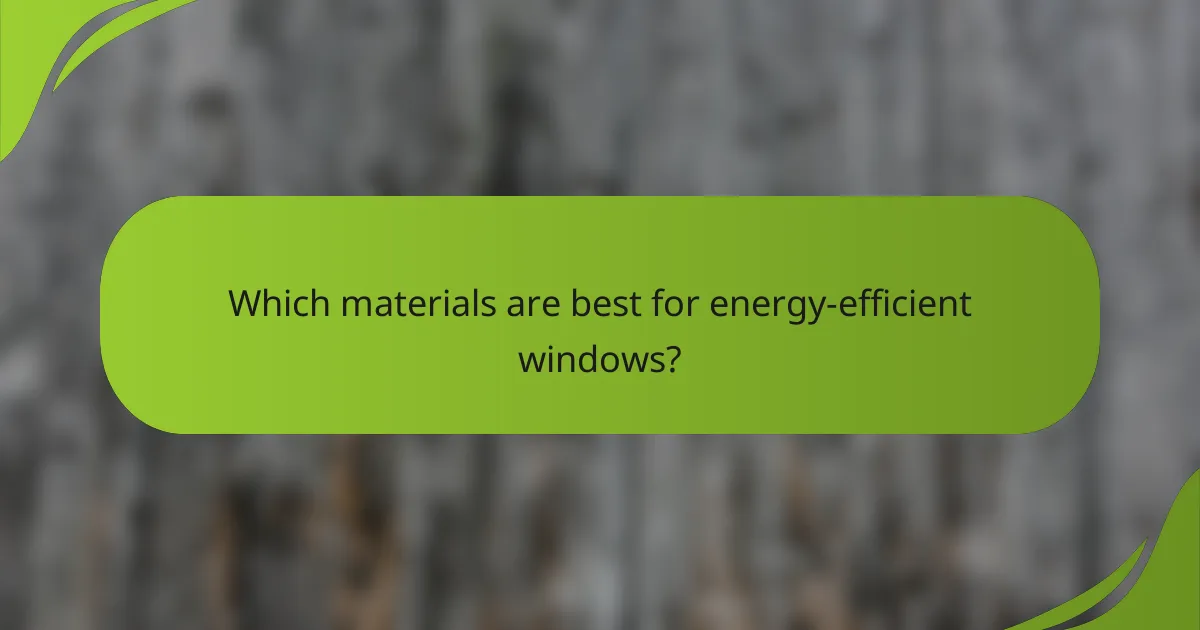
Which materials are best for energy-efficient windows?
The best materials for energy-efficient windows include vinyl and wood-clad options, each offering unique benefits in terms of insulation, durability, and aesthetics. Selecting the right material can significantly impact energy savings and overall performance.
Vinyl window frames
Vinyl window frames are popular for their excellent insulation properties and low maintenance requirements. They typically feature multi-chambered designs that trap air, enhancing thermal performance and reducing energy costs.
When considering vinyl frames, look for options with a high R-value, which indicates better insulation. They are available in various colors and styles, making them a versatile choice for many home designs.
Wood-clad window options
Wood-clad windows combine the aesthetic appeal of wood on the interior with the durability of aluminum or vinyl on the exterior. This design provides excellent insulation while protecting against weather elements, making them a great choice for historic homes.
While wood-clad windows may require more maintenance than vinyl, they offer a classic look that can enhance a home’s value. Ensure to choose products that meet local energy efficiency standards to maximize performance and compliance.
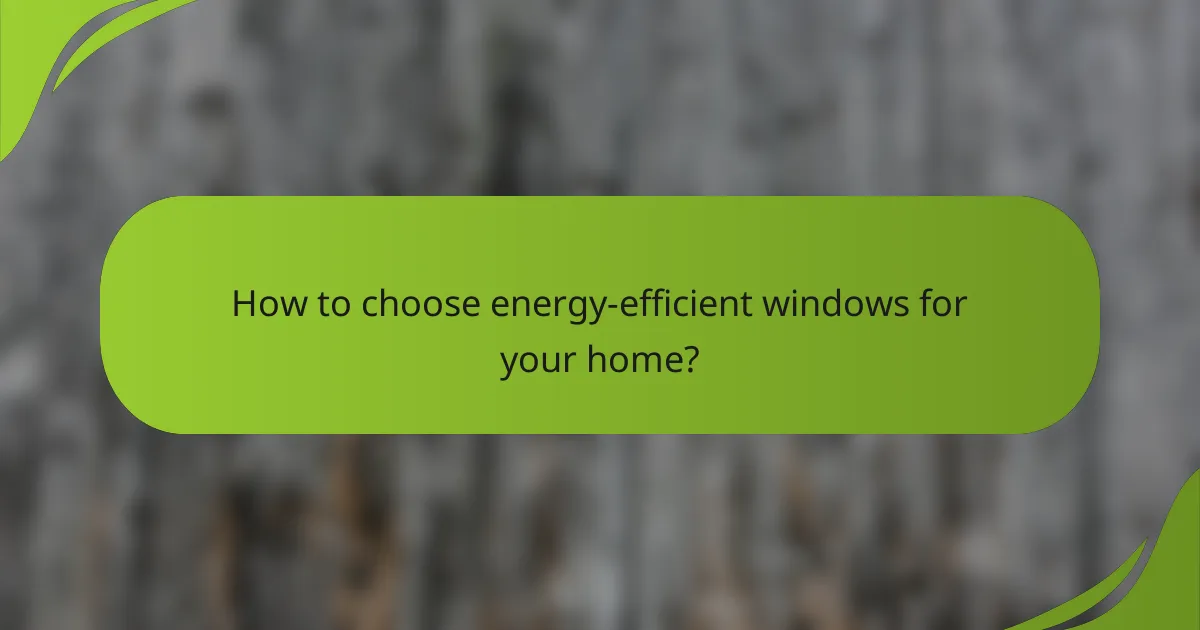
How to choose energy-efficient windows for your home?
To choose energy-efficient windows for your home, consider factors such as insulation properties, solar heat gain, and energy ratings. Selecting windows that meet or exceed local energy efficiency standards can significantly reduce heating and cooling costs.
Energy Star ratings
Energy Star ratings indicate how well a window performs in terms of energy efficiency. Windows that earn this label meet strict energy performance criteria set by the U.S. Environmental Protection Agency (EPA) and can help lower energy bills.
When selecting windows, look for the Energy Star label specific to your climate zone, as requirements may vary. For instance, windows in warmer regions should have lower solar heat gain coefficients to minimize cooling costs.
U-factor and solar heat gain coefficient
The U-factor measures how well a window insulates, with lower values indicating better insulation. A U-factor of 0.30 or lower is generally recommended for energy-efficient windows, especially in colder climates.
The solar heat gain coefficient (SHGC) measures how much solar radiation passes through a window. A lower SHGC is preferable in hot climates to reduce cooling needs, while a higher SHGC can be beneficial in colder areas for passive solar heating.

What are the local regulations for installing energy-efficient windows?
Local regulations for installing energy-efficient windows vary by region and often include building codes and historic preservation guidelines. Homeowners should check with local authorities to ensure compliance with these regulations before proceeding with installation.
Building codes in major U.S. cities
Building codes in major U.S. cities typically mandate minimum energy performance standards for windows. For instance, cities like New York and Los Angeles require windows to meet specific U-factor and solar heat gain coefficients to enhance energy efficiency.
Homeowners should consult their local building department for the exact requirements, as they can vary significantly. It’s advisable to ensure that any new windows are certified by the National Fenestration Rating Council (NFRC) to meet these codes.
Historic preservation guidelines
Historic preservation guidelines often restrict the types of windows that can be installed in designated historic districts. These guidelines aim to maintain the architectural integrity of historic buildings, which may require using specific materials or styles that match the original windows.
Before replacing windows in a historic property, homeowners should seek approval from local preservation boards. They may also need to provide documentation showing that the new windows are energy-efficient while being compatible with the building’s historical character.

What are the costs associated with energy-efficient windows?
The costs associated with energy-efficient windows can vary significantly based on factors such as materials, installation, and local market conditions. Generally, homeowners can expect to invest several hundred to over a thousand dollars per window, including both purchase and installation costs.
Average pricing for installation
The average cost for installing energy-efficient windows typically ranges from $300 to $1,000 per window, depending on the type and size. Installation costs can increase if additional structural modifications are needed or if the windows are custom-made.
Labor costs also play a crucial role, with professional installation fees averaging between $100 and $300 per window. It’s advisable to obtain multiple quotes from contractors to ensure competitive pricing and quality service.
Long-term savings on energy bills
Investing in energy-efficient windows can lead to significant long-term savings on energy bills, often reducing heating and cooling costs by 10% to 25%. The exact savings depend on factors such as local climate, energy rates, and the efficiency of the existing windows.
For example, if a household spends around $2,000 annually on energy, upgrading to energy-efficient windows could potentially save $200 to $500 each year. Over time, these savings can offset the initial investment, making energy-efficient windows a financially sound choice.

What are the best brands for energy-efficient windows?
Some of the top brands for energy-efficient windows include Andersen, Pella, and Marvin. These manufacturers are known for their high-quality materials, innovative designs, and adherence to energy efficiency standards.
Andersen Windows
Andersen Windows offers a wide range of energy-efficient options, including their 400 Series and A-Series. These windows feature advanced glazing technologies and durable frames, which help reduce energy loss and improve comfort.
When choosing Andersen, consider their Energy Star-rated products, which meet strict efficiency guidelines. Their windows often come with various customization options, allowing you to select styles that fit your home’s aesthetic.
Pella Windows
Pella Windows is recognized for its innovative designs and energy-efficient features, particularly in their Lifestyle and Impervia series. These windows utilize advanced insulation and low-E glass to minimize heat transfer.
Look for Pella’s triple-pane options if you live in regions with extreme temperatures, as they provide enhanced insulation. Their products are also available in various finishes and styles to complement your home’s architecture.
Marvin Windows
Marvin Windows is known for its commitment to sustainability and energy efficiency, particularly with its Infinity and Elevate lines. These windows are made from fiberglass, which offers superior thermal performance and durability.
Marvin’s energy-efficient windows often come with a range of customizable options, including different colors and finishes. Their products are designed to meet or exceed Energy Star requirements, making them a reliable choice for homeowners focused on efficiency.
